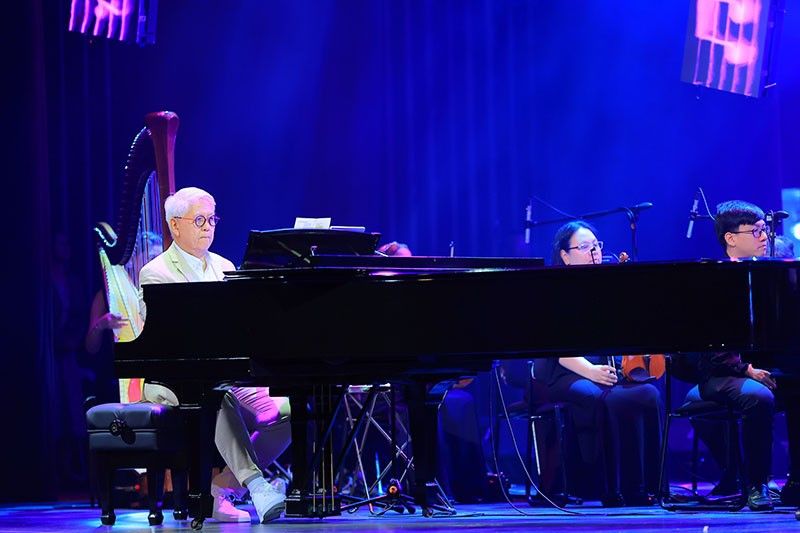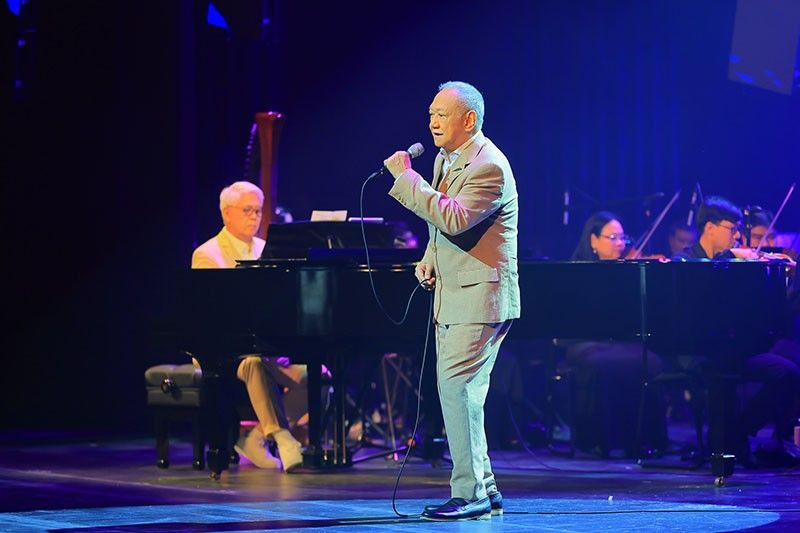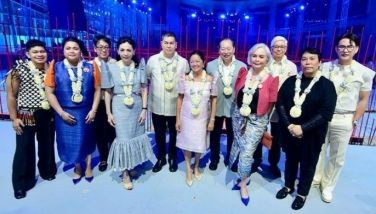Gen C: On music encompassing across generations

In anyone’s youth, one never has an inkling what 40 years hence would look like as one follows his or her calling to do what he or she does best. For all his focus, creativity and genius, the same couldn’t have have held truer for Ryan Cayabyab.
I will never forget the day I met him at a rehearsal for the New Minstrels, whose shows I ended up writing for a good number of years, directed by my husband. We entered the rehearsal room and above everyone else’s head was a fluff of bubble-like hair bobbing up and down to the beat of a piano piece being played by the owner of the bubble hair, the pianist, Ryan Cayabyab, then known as Cip. We were introduced and that was the start of a number of collaborative years with Ryan as the musical director for practically most of our live shows and television specials. Everyone was in their 20s and things were going full speed ahead.
And now, 40 years after. Its Ryan’s 70th birthday concert. It opens with the piece he is most associated with, “ Kay Ganda ng Ating Musika,” which was first sung by Hajji Alejandro for the first Metropop Music Festival in 1978, capping the grand prize for Ryan as its composer. The familiar drum roll and the fanfare-like opening strains of the piece never fails to set a festive mood, practically making it the anthem of Original Pilipino Music, a phrase first coined by Danny Javier of the Apo, defining the music genre of that time. And as if the song was not celebratory enough, it was followed by “Hibang sa Awit” sung by the Ateneo Chamber Singers, which underscores the impact of music on human emotions that affects one’s consciousness. The lyrics of Jose Javier Reyes, descriptive as they already are, further expresses “how music could be related to the human heart and how it provokes the deepest emotions and feelings within one’s being,”as shared by Sarah G. in Sonichits.com.

And with that song in place, the tempo sobers up as Basil Valdez’s caressing but rich tenor starts with “Paraisong Parisukat,” the theme from the movie co-authored by Orlando Nadres and Jose Javier Reyes, outlining the lives of people working in a shoe store and the desire to be liberated from the confines of 4 walls, as expressed in the lyrics “ tayo na giliw sa malawak na kalikasan at salubinging and bukang-liwayway…” Then, the lilting musical cadence of “Nais Ko” with the poetic verses of Rolando Tinio’s expressions follows, further expressing this desire for a free and open life, even if it means living life all over again.
By now, the audience gets a bit of a hint that this show in not to be an ordinary enumeration of Maestro Cayabyab’s Greatest Hits, but is, in fact, a narrative driven by a creative curation
of his music, interpreted by various artists, carefully chosen to give life not just to the music and lyrics, but indeed, to personify the whole intent of the composer thru his particular artistic genre with each song.
“ Limang Dipang Tao,” performed by The Company, and “Tsismis,” originally recorded in a capella by Ryan himself in his first album, “One,” was sung by Kakai Bautista, Mikkie Bradshaw Volante and Phi Palmos. Conceptually set in noisy environments ( “Limang Dipa,” in the streets of Quiapo and “Tsismis” in a gossip-driven atmosphere), the compatibility of the music, performers and lyrics help drive the listeners’ imagination to a suitable situation and location.
“Kailan” was composed originally for a group of young singers formed by Maestro Ryan in the ‘80s christened “Smokey Mountain,” named after the area which was the dumping ground for the city’s trash. Socially relevant for that time, it was nonetheless a youthful expression of young love and crushes as sung that evening by Julie Anne San Jose. “Can This Be Love” continues the search for true emotions in perhaps young adults, looking for what defines true love sung by Janella Salvador. Then to express the painful side of what could have been true love, Jed Madela’s distinct counter tenor in “How Can I’, in tandem with “Once Upon a Life” pleads for an answer as to why seemingly ideal relationships go awry expressed by Jed’s pleading cadence that can only define heartbreak.

So as not to wallow in love struck despair, Maestro Ryan counters it with his most performed song globally,with countless singing groups doing their own interpretation of the Coconut Nut. That evening, the song was performed by popular P-Pop group, Bini, a group of 8 happy song and dance young’uns giving their own brand of life to the Maestro’s tribute to the Filipino buko.
Fernando Poe Jr’s 1980 film “Aguila”,ushers in the film segment of the Maestro’s work. “Aguila’s theme song, “Iduyan Mo” is sung by Ateneo Chamber Singers. Although its soundtrack has an undertone of action, its sung version comes off as a lullabye. The full bodied voice of Bituin Escalante resonates in jazzy chords within the theater walls with “Hello Joe, Goodbye” from the film “Desire,” a 1982 Fil-American film directed by Eddie Romero.
Then diving into current music genres, top rated popular band, Ben &Ben brings the house down with “ Comets” and a mash-up of the bands original work, “Leaves” and the Maestro’s classic “Tuwing Umuulan” culminating with “ Ride Home.” An important point raised by the Maestro was his penchant for wanting to mentor younger generations of singers and musicians who have approached him. Spending time with them, learning about their styles becomes a cross-generational learning curb, something that was obvious in his warm onstage repartee with Ben & Ben.
More generational collaborations are heard in “Angat sa Iba” by Ateneo Chamber Singers and rapper, singer and songwriter known professionally as Gloc-9. An almost theatrical interpretation of “Paraiso” is performed by Juan Karlos who heads his band of the same name. Apart from being a singer, he also plays multiple instruments and is an actor. Thus it should not be surprising that his version of Paraiso is enacted as well as sung, to the delight of the audience. A surprise appearance of Vice Ganda whose short stand-up comic act preceding his surprisingly wonderful version of “ Walang Katulad” contributes to an additional feature of the concert. This is followed by yet another surprise number from Martin Nievera singing once more “How Can I” in his tear- jerking singing style. A quiet moment follows with the Maestro and his wife, Emmy singing the song they composed for their wedding day, “ Tunay na Ligaya.”

The divide of musical generations by now is clear to the audience, hearing the differences of singing styles, as observed by theater critic Gibbs Cadiz. Of the new generation, he cites that “voices have become of a uniformly ‘higher’ register, no longer the big-voiced straightforward singing of the past and now usually tending to R&B with its requisite riffs, runs, and “kulot” …
But in the dominant era of R&B and hip-hop-inflected popular music, I also do miss the rich, robust, warm voices of classic Pinoy pop, wedded to expertly crafted songs (by Mr C, Willy Cruz, George Canseco, et al) that, above all, celebrated melody and the long beautiful vocal line. Nonoy Zuniga, who along with Basil Valdez, defined the Filipino balladeer sound when I was growing up in the ‘80s. And I felt a twinge of — ‘sayang’? — because that kind of full-bodied male vocal sound seems to have largely gone out of fashion. Nonoy Zuniga’s elegant, soothing baritone — in songs like Doon Lang, Kumusta Ka, Live for Love, Love Without Time, Fragments of Forever, If I Could Only Say the Words, Never Ever Say Goodbye (his Basang Basa sa Ulan was also the first version I heard of the song — a universe away from Aegis’) — was a balm to the ears and the spirit. Then there was Basil Valdez’s ardent, urgent, sinewy tenor, na ang sarap-sarap pakinggan and could go from the rapturous highs of Ngayon at Kailanman or Nais Ko to the profound, soulful stillness of Salamin ng Buhay…..(But) this is not a knock on the current crop of Pinoy male pop singers, but observation lang”.
For each generation, comes an identifying audal style it seems, though nothing deters musical genius to bridge the gap between the years. As a wise man clearly said, where art is concerned, there are only two criteria: good or bad.
By the end of the concert, the grand finale couldn’t have been grander with a medley of the Maestro’s masterpieces “ Ang Larawn,” “Alikabok,” “Katy,” “ Rama Hari,” “ Noli Me Tangere” Sung by theatrical voices John Arcilla, RCS Boys, Poppert Bernadas, Karylle Tatlonghari, Arman Ferrer, Sheila Valderama, Nonie BUencamino, Menchu Lauchengco, Aicelle Santos. A video wall of absentee singers who had collaborated with the Maestro, Lea Salonga, Hajji Alejandro, Gary Valenciano, Sarah Geronimo, Krina Cayabyab and more. The final song was from the musical “Katy” sung by John Arcilla and the Musicalles cast,” Minsan Minahal Mo Ako”… “akala ko ang mundo na ay akin, ngunit hindi pala ganyan. Kay bilis makalimutan na minsan minahal ay ako…”
highlighting the probability of a short-lived memory of something or someone once loved, lost through time.
Maestro Ryan Cayabyab clearly not merely bridges the generational musical gaps through time, he defines them. And that is hard to forget.



















